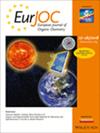有机硼催化区域糖基化和立体选择性糖基化研究进展
IF 2.7
3区 化学
Q2 CHEMISTRY, ORGANIC
引用次数: 0
摘要
糖苷键的高效和立体选择性形成仍然是碳水化合物化学中长期存在的挑战,特别是在复杂聚糖的合成中,而传统的化学方法通常涉及金属基催化剂,并且需要苛刻的反应条件,这导致化学,立体,有时区域控制减少,特别是当底物的化学复杂性增加时。近几十年来,有机催化是一种革命性的方法,它提供了可持续和选择性的糖基化策略。在探索的各种有机催化剂中,有机硼作为糖基化反应的温和和多功能活化剂以及控制区域选择性和立体选择性表现出了非凡的前景。本文综述了近年来硼基有机催化剂,特别是有机硼烷和硼酸在糖基化反应中的应用进展。本文的重点是它们作为路易斯酸的机制作用,它们与含羟基底物的相互作用,以及它们调节区域选择性和立体选择性的能力。硼酸和有机硼烷在促进1,2 -顺式和1,2 -反式糖苷键,激活各种类型的糖基供体,以及在温和条件下实现区域和立体选择转化方面的关键贡献进行了严格的研究。本文分为两个主要部分:第一部分主要关注高刘易斯酸性硼烷B(C6F5)3催化的糖基化,第二部分讨论RB(OH)2基糖基化及其未来研究的潜力。本文章由计算机程序翻译,如有差异,请以英文原文为准。

Advances in Organoboron‐Catalyzed Regio‐ and Stereoselective Glycosylation
The efficient and stereoselective formation of glycosidic bonds remains a long‐standing challenge in carbohydrate chemistry, particularly in the synthesis of complex glycans, while conventional chemical methods often involve metal‐based catalysts and require harsh reaction conditions, which result in reduced chemo‐, stereo‐, and sometimes regiocontrol, particularly as chemical complexity in the substrates increases. In recent decades, organocatalysis has been a revolutionary approach, which offers sustainable and selective glycosylation strategies. Among the various organocatalysts explored, organoborons have demonstrated exceptional promise as mild and versatile activators of glycosylation reactions and for controlling the regioselectivity and stereoselectivity. This review highlights the recent advances in the use of boron‐based organocatalysts, specifically organoboranes and boronic acids, in glycosylation reactions. Herein, the focus is placed on their mechanistic roles as Lewis acids, their interactions with hydroxyl‐containing substrates, and their ability to modulate regioselectivity and stereoselectivity. Key contributions of boronic acids and organoboranes in promoting 1,2‐cis and 1,2‐trans glycosidic linkages, activating various classes of glycosyl donors, and enabling regio‐ and stereoselective transformations under mild conditions are critically examined. It is divided into two main sections: the first part focuses on the highly Lewis‐acidic borane B(C6F5)3 catalyzed glycosylation, and the second part discusses RB(OH)2‐based glycosylation and its potential for future research.
求助全文
通过发布文献求助,成功后即可免费获取论文全文。
去求助
来源期刊
CiteScore
5.40
自引率
3.60%
发文量
752
审稿时长
1 months
期刊介绍:
The European Journal of Organic Chemistry (2019 ISI Impact Factor 2.889) publishes Full Papers, Communications, and Minireviews from the entire spectrum of synthetic organic, bioorganic and physical-organic chemistry. It is published on behalf of Chemistry Europe, an association of 16 European chemical societies.
The following journals have been merged to form two leading journals, the European Journal of Organic Chemistry and the European Journal of Inorganic Chemistry:
Liebigs Annalen
Bulletin des Sociétés Chimiques Belges
Bulletin de la Société Chimique de France
Gazzetta Chimica Italiana
Recueil des Travaux Chimiques des Pays-Bas
Anales de Química
Chimika Chronika
Revista Portuguesa de Química
ACH—Models in Chemistry
Polish Journal of Chemistry.

 求助内容:
求助内容: 应助结果提醒方式:
应助结果提醒方式:


